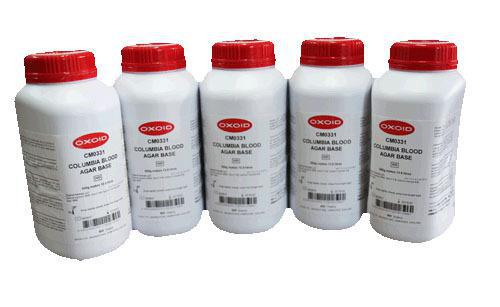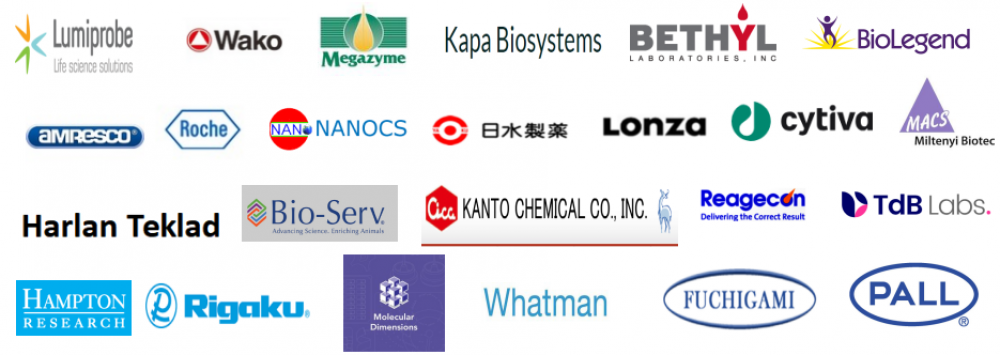Oxoid代理 CM0337B MH琼脂(MHA) MUELLER HINTON AGAR成分表
MUELLER-HINTON AGAR
Code: CM0337
An antimicrobial susceptibility testing medium which may be used in internationally recognised standard procedures.
| Typical Formula* |
gm/litre |
| Beef, dehydrated infusion from |
300.0 |
| Casein hydrolysate |
17.5 |
| Starch |
1.5 |
| Agar |
17.0 |
| pH 7.3 ± 0.1 @ 25°C |
* Adjusted as required to meet performance standards
Directions
Add 38g to 1 litre of distilled water. Bring to the boil to dissolve the medium completely. Sterilize by autoclaving at 121°C for 15 minutes.
方向
将 38 克加入 1 升蒸馏水中。 煮沸以完全溶解培养基。 通过在 121°C 高压灭菌 15 分钟进行灭菌。
Description
Mueller-Hinton Agar was designed to be a reproducible culture medium for the isolation of pathogenic Neisseria species (Mueller and Hinton1). The inclusion of starch ensures that toxic factors found during growth will be absorbed and its presence is often essential to establish growth from very small inocula2.
However, specific GC media have replaced Mueller-Hinton Agar for this purpose.
The major use of Mueller-Hinton Agar is for Antimicrobial Susceptibility Testing (AST). It has become the standard medium for the Bauer-Kirby method3,4, and is specified by the Clinical & Laboratory Standards Institute (CLSI) formerly the National Committee for Clinical Laboratory Standards (NCCLS)5,6,7 and The European Committee on Antimicrobial Susceptibility Testing (EUCAST)8.
Oxoid Mueller-Hinton Agar meets the requirements of WHO9,10. Criticisms have been made about variation in performance of Mueller-Hinton Agar between and with manufacturers’ batches/lots of medium11. The causes of such variation are:
1. Differences in concentration of divalent cations Mg++ and Ca++. These effects are shown as MIC variations with aminoglycosides against Pseudomonas aeruginosa and tetracycline against staphylococci12,13,14.
2. Variation in thymine and thymidine content, which affect sulphonamide and trimethoprim MIC values15,16.
3. The concentration of manganese, which affects resistance interpretations with glycylcylines17.
4. The concentration of zine, which affects resistance interpretations with imipenem and potentially other carbapenems.18
5. Differences in the characteristics of the agar used in the medium, especially diffusion properties19.
In the light of such criticisms the CLSI called interested manufacturers together to discuss the standardization and stabilization of Mueller-Hinton Agar. Control methods were established whereby critical antimicrobial/organism combinations had to yield consistent zones of inhibition within 2mm of the specified diameters in the standards7.
The result of this cooperative effort is that Mueller-Hinton Agar became a standard medium and as well as being the medium of choice for CLSI methodology it is also specified by EUCAST8. The medium meets the criteria described in the Technical Specification ISO/TS 16782:201618.
描述
Mueller-Hinton 琼脂被设计成一种可重复的培养基,用于分离致病性奈瑟氏菌(Mueller 和 Hinton1)。包含淀粉可确保在生长过程中发现的有毒因子被吸收,并且它的存在对于从非常小的接种物开始生长通常是必不可少的。
但是,为此目的,特定的 GC 培养基已取代 Mueller-Hinton 琼脂。
Mueller-Hinton Agar 的主要用途是用于抗菌药敏试验 (AST)。它已成为 Bauer-Kirby 方法 3、4 的标准培养基,并由临床和实验室标准协会 (CLSI) 前身为国家临床实验室标准委员会 (NCCLS) 5、6、7 和欧洲抗菌委员会指定敏感性测试 (EUCAST) 8。
Oxoid Mueller-Hinton 琼脂符合 WHO9,10 的要求。有人批评了 Mueller-Hinton 琼脂在制造商批次/批次培养基之间的性能差异11。这种变化的原因是:
1.二价阳离子Mg++和Ca++的浓度差异。这些影响显示为氨基糖苷类抗铜绿假单胞菌和四环素抗葡萄球菌 12、13、14 的 MIC 变化。
2. 胸腺嘧啶和胸苷含量的变化,影响磺胺和甲氧苄啶的 MIC 值15,16。
3. 锰的浓度,影响对甘氨酰环素的抗性解释 17。
4. 锌的浓度,它会影响对亚胺培南和其他碳青霉烯类药物的耐药性解释。 18
5. 培养基中使用的琼脂特性的差异,尤其是扩散特性19。
鉴于这些批评,CLSI 召集感兴趣的制造商一起讨论 Mueller-Hinton Agar 的标准化和稳定性。建立了控制方法,其中关键的抗微生物剂/生物体组合必须在标准中指定直径的 2 毫米内产生一致的抑制区7。
这种合作努力的结果是 Mueller-Hinton Agar 成为标准培养基,并且作为 CLSI 方法的首选培养基,它也被 EUCAST8 指定。该介质符合技术规范 ISO/TS 16782:201618 中描述的标准。
Antibiotic susceptibility tests are performed in accordance with and meet the acceptance limits of the current ISO/TS 16782 using the following microorganisms:
Staphylococcus aureus ATCC®25923 WDCM00034
Staphylococcus aureus ATCC®29213 WDCM00131
Staphylococcus aureus ATCC®43300 WDCM00211
Staphylococcus aureus NCTC 12493 WDCM00212
Escherichia coli ATCC®25922 WDCM00013
Escherichia coli ATCC®35218
Pseudomonas aeruginosa ATCC®27853 WDCM00025
Enterococcus faecalis ATCC®33186 WDCM00210
Enterococcus faecalis ATCC®29212 WDCM00087
Streptococcus pneumoniae ATCC®49619
Haemophilus influenzae ATCC®49247
Haemophilus influenzae ATCC®49766
Mueller-Hinton Agar supplemented with yeast, NAD and haematin is used specifically for the susceptibility testing of Haemophilus influenzae20. For further details see Haemophilus Test Medium (HTM), CM0898.
Mueller-Hinton Agar supplemented with 5% defibrinated horse blood (SR0050) and 20 mg/L β-NAD is specified by EUCAST for testing fastidious organisms.
Mueller-Hinton Agar and Broth are used as the basis of solid and liquid media containing cefoperazone, trimethoprim, piperacillin and cycloheximide for selective isolation of Arcobacter spp. from meats21.
Storage conditions and Shelf life
Store the dehydrated medium at 10-30°C and use before the expiry date on the label.
Store the prepared plates at 2-8°C.
储存条件和保质期
将脱水培养基储存在 10-30°C 并在标签上的有效期之前使用。
将准备好的板储存在 2-8°C。
Appearance
Dehydrated medium: Straw coloured, free-flowing powder
Prepared medium: Straw coloured gel
外貌
脱水介质:稻草色、自由流动的粉末
制备培养基:稻草色凝胶
Quality control
| Positive controls: | Expected results |
| Escherichia coli ATCC® 25922 * | Good growth; pale straw coloured colonies |
| Pseudomonas aeruginosa ATCC® 27853 * | Good growth; straw coloured colonies |
| Staphylococcus aureus ATCC® 25923 * | Good growth; cream coloured colonies |
| Negative control: | |
| Uninoculated medium | No change |
* This organism is available as a Culti-Loop®
Note: Please refer to relevant standards for further quality control testing
Precautions
Incubation in a carbon dioxide enriched atmosphere is not recommended because of its pH effect on the medium. If it is imperative to use CO2 then known control organisms should be included with the test plates to measure its effect.
Carbohydrates should not be added to Mueller-Hinton Agar because they may influence the rate of growth of the organism and the resulting pH of the medium.
The addition of lysed horse blood to the medium may further reduce the levels of thymidine and prevent the growth of thymidine-dependent organisms.
The medium may not support the growth of some fastidious strains for example microorganisms that require thymine and thymidine for growth. Close adherence to the methodology is required to obtain satisfactory results.
References
1. Mueller J. H. and Hinton Jane (1941) Proc. Soc. Exp. Biol. and Med. 48. 330-333.
2. Olsen A. M. and Scott W. J. (1946) Nature 157. 337.
3. Bauer A. W., Kirby W. M., Sherris J. C. and Turck M. (1966) Amer. J. Clin. Path. 45. 493-496.
4. Ryan K. J., Schoenknecht F. D. and Kirby W. M. (1970) Hosp. Pract. 5. 91-100.
5. CLSI Performance Standards for Antimicrobial Disk Susceptibility Testing; CLSI Supplement M100S Wayne PA: Clinical and Laboratory Standards Institute
6. CLSI Performance Standards for Antimicrobial Susceptibility Tests; Approved Standard. CLSI Document M02. Wayne PA: Clinical and Laboratory Standards Institute
7. Pollock H. M. et al. (1986) J. Clin. Microbiol. 24. 1-6.
8. European Committee on Antimicrobial Susceptibility Testing. EUCAST disc diffusion Test Methodology www.eucast.org
9. WHO (1961) Standardization of Methods for Conducting Microbic Sensitivity Tests. Geneva. Tech. Rep. Ser. No.210.
10. WHO (1977) Expert Committee on Biological Standardization. Geneva. Tech. Rep. Ser. No.610.
11. Barry A. L. and Effinger L. J. (1974) Amer. J. Clin. Path. 62. 113-117.
12. Reller L. B., Schoenknecht F. D., Kenny M. A. and Sherris J. C. (1974) J. Infect. Dis. 130. 454-463.
13. D’Amato R. F., Thornsberry C., Baker N. and Kirven L. A. (1975) Antimicrob. Agents Chemotherap. 7. 596-600.
14. D’Amato R. F. and Thornsberry C. (1979) Curr. Microbiol. 2.135-138.
15. Ferone R., Bushby S. R. M., Burchall J. J., Moore W. D. and Smith D. (1975) Antimicrob. Agents Chemotherap. 7. 91-98.
16. Ferguson R. W. and Weissfeld A. S. (1984) J. Clin. Microbiol. 19. 85-86
17. Veenemans J., Mouton J.W., Kluytmans J.A,J.W., Donnerly R. Verhulst, C., van Keulen, PHJ. Effect of manganese in test media on in vitro susceptibility oe Enterobacteriaceae and Acinetobacter baumannii to tigecycline. J.Clin.Microbiol 2012, 50 pp. 3077-3079
18. Daly J.S.m Dodge R.A., Glew R.H., Soja D.T., Deluca B.A., Herbert S. Effect of zince concentration in Mueller-Hinton agar on susceptibility of Pseudomonas aeruginosa to imipenem. J. Clin. Microbiol. 1997, 35 pp. 1027-1029
19. Bridson E. Y. and Brecker A. (1970) in `Methods in Microbiology’ Eds. Norris and Ribbons. Vol.3A Academic Press London. pp. 257-266.
20. International Organization for Standardization ISO/TS 16782:2016 Clinical laboratory testing – Criteria for acceptable lots of dehydrated Mueller-Hinton agar and broth for antimicrobial susceptibility testing.
21. Jorgensen J. H., Redding J. S., Maher L. A. and Howell A. W. (1987) J. Clin. Microbiol. 25. 2105-2113.
22. De Boer E., Tilburg J. J. H. C., Woodward D. L., Lior H. and Johnson W. M. (1996) Left. Appl. Microbiol. 23. 64-66.

